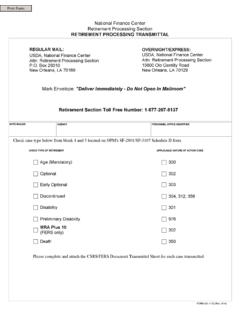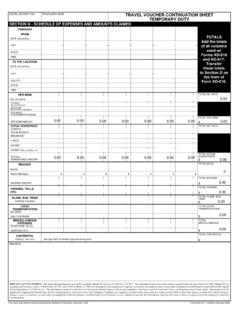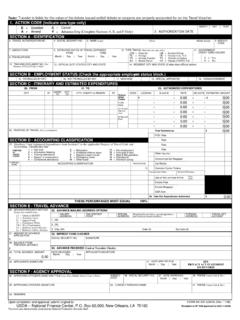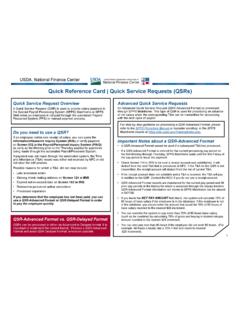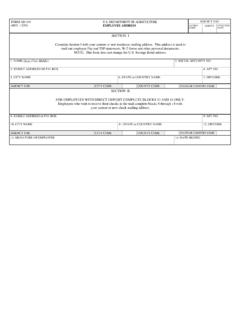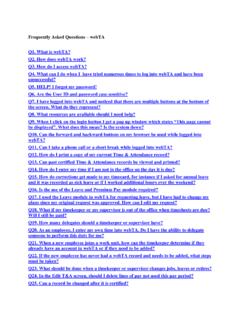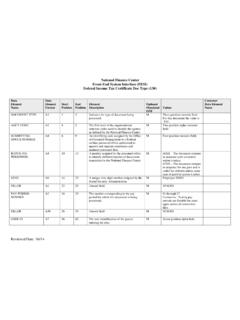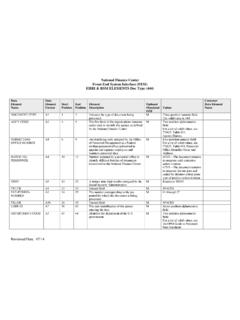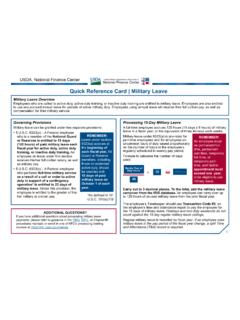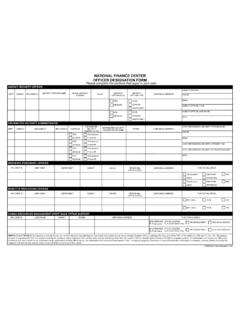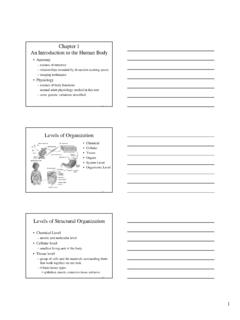Transcription of Chapter 1 Introduction - National Finance Center
1 Detail Design Document 5/24/2004 1-1 AG304S4 Chapter 1 introduction Department of Agriculture (USDA) comprises more than 30 agencies that combine to create a physical presence in virtually every county in the nation, as well as in territories and international locations. Together, these agencies are responsible for a huge portfolio of property both real and personal. USDA owns nearly 22,000 buildings and approximately 190 million acres of land, and it has more than 1,100 space assignments in 747 General Services Administration (GSA) buildings in 442 cities and towns. USDA is the second largest landholder in the Federal Government, second only to the Department of the Interior. In addition, USDA leases space in approximately 3,600 commercial buildings with an annual rent of more than $150 million. USDA s real and personal property is the third largest item in the Department s balance sheet.
2 During fiscal year 2002, the USDA initiated the fundamental analytic work to address its need to invest in a corporate, Department-wide asset management system. Without such a system, USDA cannot comply with applicable laws and regulations for financial management, information security, and internal controls. Such a system is also critical to the Department s ability to improve customer service, organizational productivity, accountability, and performance. To identify a systematic, long-term solution to its asset management requirements, USDA conducted a business case analysis in accordance with the Office of Management and Budget requirements for investments. This included a market survey, to which the Forest Service (FS) responded and proposed its Infrastructure System (INFRA Central), a real property management and accounting application that is integrated with a wide-ranging set of asset management applications, as a potential solution for the Department.
3 The real property currently being managed by INFRA Central represents approximately 85 percent of the total of USDA-owned property. INFRA Central substantially meets the Agency, Joint Financial Management Improvement Program (JFMIP), and other federal requirements. As a result of the market survey, USDA identified three alternatives for the asset management solution: 1) deploy a commercial off-the-shelf (COTS) product, 2) deploy an upgraded version of the INFRA Central Department-wide, and 3) deploy a hybrid solution that uses INFRA Central for real property management and accounting, and a COTS product for personal property management. USDA evaluated the ability of each of the alternatives to meet four criteria: performance (defined as alignment, requirements, interoperability, and scalability), cost, schedule, and risk. Detail Design Document 1/13/2016 1-2 Based on the analysis of alternatives, USDA decided to implement the Corporate Property Automated Information System (CPAIS) as a subset of the Department s asset management system and approach to reduce risks.
4 This solution enables USDA to leverage INFRA Central existing real property management capability and user base. To ensure the success of this critical project, USDA and FS have undertaken a strategic initiative to cooperate in implementing the CPAIS solution that incorporates the functionality and flexibility of the current FS INFRA Central system. The roles and responsibilities of all the parties involved in the implementation, operations and maintenance of CPAIS have been clearly identified. A Service Level Agreement (SLA) between the USDA Associate Chief Financial Officer for Financial Systems, (ACFO-FS), Office of Procurement and Property Management (OPPM), the National Information Technology Center (NITC) and the Forest Service INFRA Development Team has been executed to accomplish the implementation. PURPOSE The purpose of this document is to provide the detailed design specifications for CPAIS.
5 This document includes information collected and documented at various development life cycle phases. Programmers and engineers will be able to develop CPAIS in full compliance with the USDA requirements. Furthermore, this document will assist maintainers to apply future modifications and upgrades to the system with minimal adverse effect to the overall functionality of the system. Information necessary and pertinent to the design of the CPAIS has been organized and consolidated in one document. This will enable programmers, engineers, and maintainers of the system to access information with ease and efficiency afforded by this consolidation. Therefore, certain sections of the document have been copied in part or in full from previously published documents. OVERVIEW The implementation of CPAIS for real property will provide USDA with a single consolidated inventory of its real property assets.
6 CPAIS will provide a real property asset management system that is integrated with the corporate financial management system and interfaced with related GSA real property related systems. The implementation of CPAIS will result in improved asset control, tracking, and assurance. Additionally, it will provide for enhanced electronic data storage and exchange, which will improve collection and availability of property information including leases and GSA assignments. Agencies will be able to access real property information online and in real-time. Figure 1 depicts the relationship of CPAIS to the corporate financial system, Foundation Financial Information System (FFIS), the Forest Service INFRA system, and to the GSA System for Tracking and Administering Real Property (STAR) and Federal Real Property Profile (FRPP). Introduction 1/13/2016 1-3 Figure 1 Conceptual Relationship of CPAIS to External Systems CPAIS CPAIS is a platform independent, web-enabled real property management system based upon the Forest Service government-off-the-shelf (GOTS) Infrastructure (INFRA) system.
7 CPAIS contains a subsidiary ledger to the corporate financial system and has interfaces with FFIS. The CPAIS application is hosted at the National Information Technology Center (NITC) and end-users access the system via a web browser. The CPAIS web application has two subsystems: Real Property Management (RPM): The CPAIS Real Property Management module design supports FRPP and Exhibit 54 Capital Investment requirements. This provides consistent data to enable an accurate inventory of the Department s real property assets and supports the full life cycle of Real Property Management. Real Property Accounting (RPA): The CPAIS Real Property Accounting module provides the functionality to establish projects and their associated accounting. This includes the tracking of work-in-progress (WIP), capitalization, and depreciation of real property assets.
8 FFIS FFIS includes a USDA-configured version of the commercial off-the-shelf (COTS) Federal Financial System, a budget execution and accounting application implemented in many other federal agencies. Further, it includes USDA financial reporting solutions the Financial Data Warehouse and the Financial Statements Data Warehouse, and two data marts Automated Cash Reconciliation Worksheet System (ACRWS) and FFIS Customer Service Center (CSC). CPAISCPAISFFISFFISFFIS to CPAIS InterfaceFFIS to CPAIS InterfaceCPAIS to FFIS InterfaceCPAIS to FFIS InterfaceGSA Star/RentGSA Star/RentFederal Real Property ProfileFederal Real Property ProfileSTAR DataSTAR DataFRPP DataFRPP DataForest Service INFRAF orest Service INFRAINFRA InterfaceDetail Design Document 1/13/2016 1-4 FFIS interfaces with CPAIS monthly to transmit Journal information pertaining to real property and executes once for each agency s production application.
9 In addition to journal data, FFIS transmits data from its online tables to ensure CPAIS has the information required for update and reporting purposes. CPAIS interfaces with FFIS nightly, as needed, to generate files to send USDA agency documents creating new Unique Asset Identifiers. The CPAIS to FFIS interface runs once a month to send documents that record the accounting impact of a variety of property-related transactions, including but not limited to donations, depreciation, transfers/disposals, and balance sheet transfers for completed work. STAR The System for Tracking and Administering Real Property (STAR) is the General Services Administration (GSA) Public Buildings Service (PBS) business system for managing business data supporting the management of space and customer billing records. STAR will provide web-based billing data to CPAIS each month.
10 Federal Real Property Profile The Federal Real Property Profile (FRPP), formerly named the Worldwide Inventory, is a relational database managed by the General Services Administration to track and report all Federal owned and leased real property. USDA must provide real property data to FRPP annually in the Annual Report of Real Property Owned by or Leased to the United States. SCOPE AND DOCUMENT ORGANIZATION This document maps the CPAIS requirements to the design and describes how the system is going to be developed. The document contains information about USDA s real property and financial business processes, required application logic, database design, security design, computer resources, and 508 compliance. The document is organized as follows: Terms and descriptions: This Chapter describes the terminology used in CPAIS related to real property asset management.
